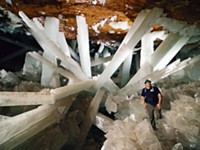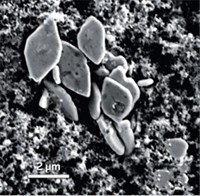Advertisement
Grab your lab coat. Let's get started
Welcome!
Welcome!
Create an account below to get 6 C&EN articles per month, receive newsletters and more - all free.
It seems this is your first time logging in online. Please enter the following information to continue.
As an ACS member you automatically get access to this site. All we need is few more details to create your reading experience.
Not you? Sign in with a different account.
Not you? Sign in with a different account.
ERROR 1
ERROR 1
ERROR 2
ERROR 2
ERROR 2
ERROR 2
ERROR 2
Password and Confirm password must match.
If you have an ACS member number, please enter it here so we can link this account to your membership. (optional)
ERROR 2
ACS values your privacy. By submitting your information, you are gaining access to C&EN and subscribing to our weekly newsletter. We use the information you provide to make your reading experience better, and we will never sell your data to third party members.
Geochemistry
Researchers have found an answer to the centuries-old dolomite problem
Modeling and in situ microscopy show how the mineral could grow at near ambient conditions
by Carolyn Wilke, special to C&EN
November 30, 2023
| A version of this story appeared in
Volume 101, Issue 40

Mountains formed of dolomite, a calcium magnesium carbonate crystal, abound. And yet researchers have struggled for hundreds of years to form the mineral in a lab at close to ambient conditions. A new study finds a way to overcome what researchers have dubbed “the dolomite problem” through cycles of undersaturation and supersaturation (Science 2023, DOI: 10.1126/science.adi3690).
“They should be really easy to grow,” says Wenhao Sun, a materials scientist at the University of Michigan.
Ten years ago, when Sun initially modeled the surface of dolomite, it was “immediately clear” why the crystals wouldn’t form, he says. The surface of dolomite had a perfect alternating order of calcium and magnesium atoms. “There’s no way that ions can come from solution in perfect alternating order,” he says.
A crucial insight came when graduate student and coauthor Joonsoo Kimsaw another researcher’s video of copper being deposited smoothly under pulses of electricity. This process caused a bit of copper to dissolve before more material was added. The team’s simulations suggested that it would take millions of years to grow a dolomite crystal through constant exposure to a supersaturated solution. Sun surmised that fluctuating conditions might help overcome the barriers in growing the crystal’s layers.
The team’s modeling showed that if a liquid solution was undersaturated—it contained less than the typical maximum amount of calcium and magnesium—this would cause some of the dolomite to dissolve. The surface would reorganize, giving the magnesium and calcium a chance to land in the correct spots. Then, if the surface was exposed to a supersaturated solution, ions could be added. Another cycle of undersaturation could shuttle these ions to the correct spots again.
Next, the researchers placed slivers of dolomite in contact with liquid and used the electron beam from transmission electron microscopy to dissolve the sample. This made a supersaturated solution, from which a bit of dolomite deposited. By repeating the process—which occurred at 80 °C—the team grew hundreds of layers of dolomite within hours. Similar patterns could happen during cycles of rain and drought or in areas that periodically flood.
“They’ve used some very novel approaches, but they did not form dolomite at Earth’s surface conditions,” says Cameron Manche, a sedimentologist at Texas A&M University who wasn’t part of the work. Manche points out that scientists have known that dolomite grows by dissolution and reprecipitation. But he finds the team’s use of state-of-the-art computational approaches, such as density functional theory, and direct observation of the crystal growth, new and impressive. “This is an important stepping stone,” he says.
The new study builds on approaches that have been used to understand the formation of other minerals, such as magnesite, says Carlos Pimentel, a geochemist at Grenoble Alpes University who wasn’t part of the work.
The approach might provide hints about how to grow other tricky crystals, including those used in solar cells or light-emitting diodes, Sun says. Dissolving semiconductor materials a little while they are being grown might help order the materials and improve their performance, he says.
CORRECTION:
This story was updated on Dec. 5, 2023, to correct the statement from Carlos Pimentel. He told C&EN that the new study builds on techniques that have been used to understand how magnesite forms, not that the study's technique could be used to study magnesite.





Join the conversation
Contact the reporter
Submit a Letter to the Editor for publication
Engage with us on Twitter